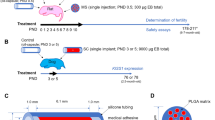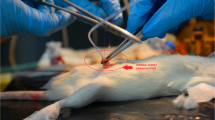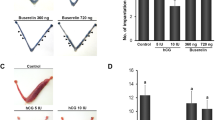Abstract
THE placement of experimental lesions in the anterior part of the hypothalamus may be followed by persistent vaginal œstrus in the guinea pig and rat. Such animals possess relatively small ovaries which have no fresh corpora lutea. Various attempts have been made to explain these effects in terms of an altered output of gonadotrophins by the pituitary gland. The original view that the secretion of luteinizing hormone was blocked1 was supported by Van Dyke et al.2, who found that in animals with persistent œstrus induced by lesions, the ovarian interstitial tissue showed a high lipid content indicative of deficiency in luteinizing hormone. Recently, Taleisnik and McCann3 reported a pituitary luteinizing hormone content in animals with persistent œstrus which was lower than in intact animals. However, after gonadectomy the amount of luteinizing hormone of persistently œstrous rats showed an increase, but the level of hormone in plasma remained low, indicating that the pituitary release of the hormone is blocked. On the other hand, Hillarp4 concluded, also on the basis of the condition of the ovarian interstitial tissue, that during persistent œstrus luteinizing hormone was still being secreted in considerable amounts. In other work, the possibility was stressed that in persistent œstrus induced by lesions, secretion of follicle stimulating hormone may be enhanced, because in animals which had been operated during the first two weeks after birth, puberty occurred at an earlier age than in control animals. After puberty, a number of these animals showed persistent œstrus5. A third possibility has been advanced by D'Angelo and Kravatz6, who assumed that in persistently œstrous rats secretion of follicle-stimulating hormone may be decreased. This assumption was based on their finding that the serum of unilaterally gonadectomized rats with persistent œstrus contained less follicle-stimulating hormone than that of cycling animals after removal of one ovary.
This is a preview of subscription content, access via your institution
Access options
Subscribe to this journal
Receive 51 print issues and online access
$199.00 per year
only $3.90 per issue
Buy this article
- Purchase on Springer Link
- Instant access to full article PDF
Prices may be subject to local taxes which are calculated during checkout
Similar content being viewed by others
References
Dey, F. L., Endocrinol., 33, 75 (1943).
Van Dyke, D. C., Simpson, M. E., Lepkovsky, S., and Brobeck, J. R., Proc. Soc. Exp. Biol. Med., 95, 1 (1957).
Taleisnik, S., and McCann, S. M., Endocrinol., 68, 263 (1961).
Hillarp, N. A., Acta Endocrinol., 2, 11 (1949).
Donovan, B. T., and Van der Werff ten Bosch, J. J., J. Physiol., 147, 78 (1959).
D'Angelo, S. A., and Kravatz, A. S., Proc. Soc. Exp. Biol. Med., 104, 130 (1960).
Cook, A. R., Texas Reports on Biol. and Med., 17, 512 (1959).
Gans, E., and De Jongh, S. E., Acta Physiol. Pharmacol. Neerl., 8, 501 (1959).
Author information
Authors and Affiliations
Rights and permissions
About this article
Cite this article
VAN REES, G., VAN DER WERFF TEN BOSCH, J. Luteinizing Hormone in Persistent Vaginal Œstrus. Nature 192, 876–877 (1961). https://doi.org/10.1038/192876a0
Issue Date:
DOI: https://doi.org/10.1038/192876a0
Comments
By submitting a comment you agree to abide by our Terms and Community Guidelines. If you find something abusive or that does not comply with our terms or guidelines please flag it as inappropriate.



